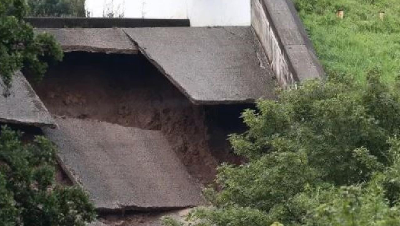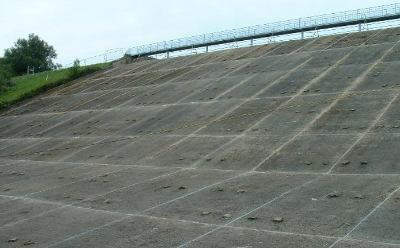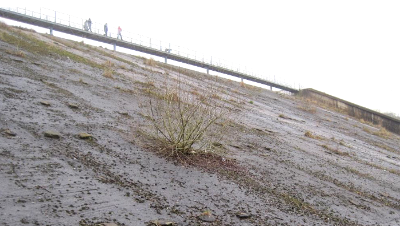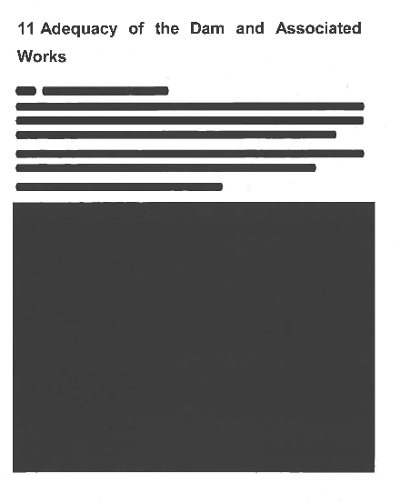FOR REASONS I won't bother readers with, I have not written on waterways related subjects for some time, Allan Richards tells us.
However, following a Defra press release into the Toddbrook incident and publication of the Balmforth report ('Intermittent maintenance' blamed for Whaley Bridge disaster), I thought some might be interested in more details.
 The Sunday Times
The Sunday Times
In general, the Press has been very critical of Canal & River Trust. In particular, The Sunday Times, quoting government sources, had this to say on 22nd March:
The owners of a dam above Whaley Bridge were repeatedly warned about safety issues before heavy rain caused it to fail last year, putting thousands of lives at risk.
An independent report shows how the Canal & River Trust (CRT) failed to carry out essential maintenance to keep the dam safe for residents of the picturesque Peak District town.
The CRT released public statements after the Whaley Bridge incident about the dam being in a “sound condition”, said the report. However, following an engineer’s 2018 inspection, the condition of the reservoir was quietly downgraded by the trust from C to D. Grade D is classed as “poor” with “structurally significant defects leading to loss of stability” generally in five to 10 years.
More than 1,500 people were forced to leave Whaley Bridge when the spillway section of the reservoir, a concrete slope used as an emergency overflow, began to crumble last August.
The incident triggered a meeting of the government’s Cobra committee. A rescue operation was launched by the RAF and emergency services to save the town, which was in danger of being washed away by 300 million gallons of water.
The dam wall was shored up with sandbags from a Chinook helicopter and the reservoir drained by the fire brigade.
Government sources are understood to be “highly concerned” about the condition of the other 71 reservoirs across the UK currently maintained by the CRT. One Whitehall source said: “This report shows a worrying lack of urgency for important repairs that were recommended, in some cases for years, by inspection engineers.
“We are taking steps to ensure this is not the case with the other reservoirs maintained by the Canal & River Trust.”
There are about 2,000 dams in England and Wales and 800 in Scotland. They create reservoirs for drinking water, fill local canals, help farms or are used for recreation. Many are above towns and cities.
The report’s author, Professor David Balmforth, warned of a gap between owners of reservoirs being “compliant with the current legislation” and “what is actually safe” for communities living in the shadow of the UK’s dams.
“Despite Toddbrook reservoir [next to Whaley Bridge] being compliant in terms of the legislation, it wasn’t actually safe,” said Balmforth. “We are now looking at how we can better improve the safety of our reservoirs across the country.”
All UK reservoirs with a capacity more than 5.5 million gallons (25,000 cubic metres) must comply with the Reservoirs Act. A civil engineer has to file an annual safety report to the Department for Environment, Food & Rural Affairs (Defra).
Katie McRoberts, 26, who has a baby boy, lives in Whaley Bridge in one of the closest houses to the dam wall. She bought the house weeks before the disaster. “I moved in about a month before it happened,” she said. “I’m still worried about it, especially now I have the baby.”
Balmforth’s report found that Toddbrook Reservoir’s spillway had a “poor design” and intermittent maintenance”, which led to its failure.
Balmford's Report
The report published last week, revealed:
From 2015 to 2018, the supervising engineer at Toddbrook stated in four separate reports that vegetation on the dam could cause cracks and create weaknesses in the joints.
No action was taken on recommendations to seal joints and cracks despite warnings before the dam’s failure, which were “material to the failure of the spillway”.
An inspecting engineer identified “key safety issues” in 2018 and gave 18 months for joints to be properly sealed, but no work was carried out.
The original design of the spillway section, built in 1969-70, was flawed because the concrete slabs were thin and lacked “sufficient reinforcement”.
Freedom of information Act
The Sunday Times has previously used the Freedom of Information Act to obtain safety inspection reports from the CRT. They were returned heavily redacted with negative comments from inspectors obscured.
As well as four reservoirs in the Peak District, the CRT has reservoirs that feed Huddersfield Narrow Canal at Sparth, Slaithwaite & Diggle, while in the West Midlands it has Windmill Pool, Terry’s Pool, Engine Pool, Cofton, Upper Bittell, Rotton Park and Chasewater, feeding Birmingham’s canals.
Richard Parry, CRT Chief Executive, said that keeping people safe was its “top priority”. stating:
“We welcome any steps that reduce risks to local people and are fully committed to acting on all the lessons learnt from this incident."
Sir James Bevan, Chief Executive of the Environment Agency, commented:
“Our reservoirs have an excellent safety record, but any incident is one too many.
“The EA will act quickly to implement these recommendations. We will continue to work closely with all reservoir owners to ensure they are maintaining and monitoring their reservoirs in line with our high safety standards.”
 Lack of routine maintenance
Lack of routine maintenance
From the governments independent Balmforth report (page 38):
'There is a long history of intermittent maintenance of the reservoir. In 2006, the Inspecting Engineer noted that the auxiliary spillway had an appearance of neglect and lack of routine maintenance. He recommended joint sealing and cleaning, removal of vegetation and patch repairs. In the 2010 inspection the Inspecting Engineer noted that the spillway appeared to Evidence of Good Maintenance with Joints cleaned out and Re-sealed, September 2008 be in good condition'.
The above photograph included in the report was captioned:
Evidence of Good Maintenance with Joints cleaned out and Re-sealed, September 2008.
 Poor maintenance
Poor maintenance
This photograph included in the report was captioned:
Evidence of Poor Maintenance with Vegetation and Saplings Growing in Joints, January 2018.
However, from 2015 to 2018 the Supervising Engineer stated, in four separate reports, that vegetation was again apparent on the spillway. There is also photographic evidence to support this. The Panel has been provided with documentary evidence on vegetation clearance on the spillway in recent years. However, vegetation clearance is only part of the necessary maintenance. It also needs to include the cleaning out and resealing of joints, and the repair of any crack.
Known issue
A local man, Graham Aldred, has produced a number of reports concerning the Toddbrook incident and is quoted directly in CaRT's report into the root cause of the incident. The report (Section 11.3) says:
“I am confident that there are significant water erosion channels under some apron panels because on occasions I have seen pulses of water mixed with air, hiss and bubble and burst out of the spillway panel gaps at the LH corner where the first panels were lifted. It happens when the reservoir is high enough for strong waves to be hitting the underside of the apron with enough pumping power to provide these observable pulses on the spillway.”
The CaRT report goes on to comment:
This phenomenon was also described by the Panel Engineer on site on 1st August, once the flow over the spillway had stopped, and could well have been caused by wave action, whilst the level was still high, causing air and water to be forced through the voids under the crest slab.
These eye-witness reports give further evidence and strength to the argument that this was a progressive failure mode involving the passage of water under the slabs on the left-hand side for many years. In other words, voids of size unknown had been forming for many years and then the event of the 1st August caused the breakup of the slabs and allowed removal of a significant amount of material at that time. It appears that previously neither the Independent Engineers, nor the Supervising Engineers, chose to investigate the issue even though there was evidence and reports of material being removed.
You may wish to read that last sentence again. CaRT's own published report admits that they were aware of issues in the area where the dam collapsed but chose not to investigate!
 Information requests
Information requests
The Sunday Times news story goes on:
The Sunday Times has previously used the Freedom of Information Act to obtain safety inspection reports from the CRT. They were returned heavily redacted with negative comments from inspectors obscured.
Here are some of the comments that CaRT obscured from one of my own information requests. They relate to measures ordered by the Inspecting Engineer be taken in the interests of safety (known as MIOS under the 1975 Reservoirs Act):
(i) a) carry out a review of the secondary overflow channel to demonstrate it is not at risk of hydro -dynamic damage during significant overflow events caused by high velocity flow in the channel or water pressure beneath the base slabs and b) carry out any necessary improvement works – thi…
Asked on 30ty January to provide information regarding any action taken at other reservoirs following the Toddbrook incident, the Trust should have responded within 20 working days. 35 working days later they have still not responded.
A need to come clean
The Reservoirs Act 1975 makes it quite clear that responsibility for the safety of Toddbrook does not lie with Defra, EA or with an independent Inspection Engineer although each has its part to play. The responsibility lies with CaRT. The Sunday Times states:
Government sources are understood to be “highly concerned” about the condition of the other 71 reservoirs across the UK currently maintained by the CRT. One Whitehall source said: “This report shows a worrying lack of urgency for important repairs that were recommended, in some cases for years, by inspection engineers.
Of particular concern is the number of reservoirs that CaRT has with spillways similar to Toddbrook and by definition not fit for purpose. CaRT needs to come clean and provide detailed assurance to the public...
¶ that it accepts the Balmforth report and its criticisms in its entirety
¶ that it will give priority to reservoir safety above other maintenance considerations.
¶ that it has already taken action to reduce risks where it has spillways similar to Toddbrook or where other major risks have been identified
¶ that it has a remedial program for all 72 reservoirs with costings
¶ that it will restore public confidence by being open in future
...or do we have to wait until people are killed?
